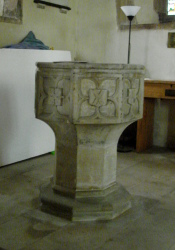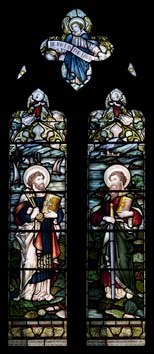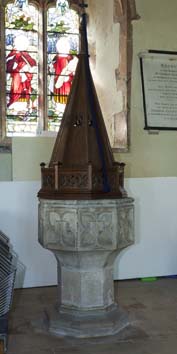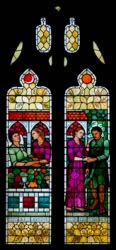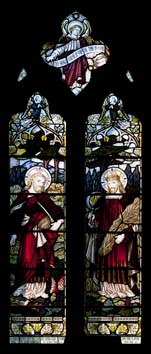Hartfield – St Mary
The nave is late C13, with a C14 south aisle and chancel. The tower and spire are C15, possibly with an older core, and the roofs and much of the chancel are C16, after fire damage.
The mediaeval parish of Hartfield covered much of Ashdown Forest. The churchyard is entered through an early C16 half-timbered cottage, forming a lychgate. There was formerly a similar cottage on the other side (Hussey p235).
The north wall of the nave is in rougher masonry, which contains a blocked trefoil-headed lancet, which shows the wall to be late C13, when the nave was probably aisleless. Though the tower is mostly C15, some of the rough walling of dark local sandstone may also be C13.
The chancel, south chapel and aisle are C14. The broad, gabled aisle has ogee-quatrefoil windows and the arcade arches have two hollow-chamfers and octagonal piers; the responds match the latter. The chamfered respond of a chancel arch between the nave arcade and the arch from chancel to chapel provides evidence of how the C14 chancel was arranged. However, the join between nave and chancel on the north side is not opposite. The arch into the south chapel resembles the south arcade, but is not in line and may have been altered too. The south chapel is early C14 – an east window has three cinquefoiled lights, the south ones have ogee-quatrefoils and the blocked continuous moulded doorway is like a blocked one in the aisle. However, the C16 roof again points to alterations.
In the C15 the tower was built or remodelled with angle-buttresses, a moulded west doorway and a window with panelled tracery. Unusually, it also has north and south windows with panelled tracery and the tall, shingled spire is a local landmark. The windows of the second stage and the bell-openings have trefoil heads; the latter are double and the altered east pair has plain square heads. The typically C15 arch has three orders, the outer two continuous and hollow-chamfered and the third on semi-octagonal shafts with wave mouldings. At this time also, two-light windows like those in the tower were placed in the north nave wall.
There is abundant evidence in the form of discoloured stone of a fire that damaged the church in the early C16, most of all the chancel (1 p188), which now has long square-headed side-windows of that date. A picture of 1874 in the church shows a segment-headed east window, also typical of the period. Inside, the changes to the arcades and removal of the chancel arch are probably a consequence of the fire. A large but shallow four-centred recess to the north was probably connected with the stair to the rood-loft, which would have stretched across the church at this point. The most obvious change is the fine crownpost roof over nave and chancel. It is slightly lower than before, as the line of the previous roof on the east side of the tower shows.
There were few further changes before the C19. Sir George G Scott did a survey in 1851 (Cole p214) but it was to be Parsons and Sons of Lewes who restored the church in 1865 (B 23 p545). J L Parsons was primarily a mason, but also undertook restorations and was probably cheaper and more malleable. The external stonework was heavily restored and the south aisle roof and timber porch were replaced. Damage by lightning to the tower and spire in 1870 led to further repairs (B 28 p974) and the present east window of thin Perp tracery replaced the C16 one (WSRO Ep/II/27/64) in 1874. In that year there was talk of consulting Scott again (ibid), but on neither occasion is the architect known for certain. Finally, in 1894 J O Scott repaved the church and designed the screens, of which none remains (BAL/MSS ScJO/2/1).
Since the C19, there have been various remodellings which have left the interior rather bare, with chairs instead of pews. In 2012 plans were announced to make the west door the entrance, so that the south porch can be converted into a toilet. It was also intended to insert a kitchen into the western part of the south aisle.
Fittings and monuments
Font: C15 or C16 with an octagonal bowl. On each side a quatrefoil encloses in some cases a shield and in others a heraldic rose.
Glass:
1. (East window) Ward and Hughes, 1874 (WSRO ibid).
2. (South aisle, west, second and third windows) A O Hemming, 1906-08 (one signed).
3. (West window) W Wailes, c1857 (www.stainedglassrecords.org retrieved on 4/3/2013). The colours are characteristically bright.
4. (North nave, third window) Lawrence and Co, 2000 (signed). The colours are predominantly green and mauve.
Monuments:
1. (South chapel) Richard Randes, Rector (d1640). Though small, this has black marble columns, a broken pediment, alabaster scrolls and an obelisk in the centre, framing the inscription. This has an oddly defiant conclusion: ‘Farewell, ye mortals, I sleep until the loud trumpet shall sound’.
2. (South aisle floor) John Mills (d1702) iron slab with, unusually, an engraved inscription.
3. (South chancel) Captain Bladon Swiney (d1790) by B and R Shout (Roscoe p1125).
4. (West wall of nave) Frederica Louisa Maitland (d1822). Marble roundel by J Coles (ibid p303).
5. (South chapel) Richard Davies (1823) by C Regnart (ibid p1028).
6. (West wall of nave) Samuel Slade (d 1829) signed R Gaffin of Regent Street.
7. (North chancel) Christina Kidd (d1820) and John Kidd (d1831) by J J Sanders (ibid p1092).
8. (North aisle) Henry Jackson (d1841) by T Denman (ibid p362).
9. (South aisle) Admiral the Hon Jacob Henniker (1843) by T and E Gaffin (ibid p487). This is by some way the most elaborate monument in the church, surmounted by a ship in full sail with heraldry beneath the inscription.
Piscinae:
1. (South aisle) C14 ogee-headed with a renewed bowl.
2. (South chancel) C14 and similar, though larger and with a shelf. The bowl has been restored.
Stoup: (South aisle) C14 with an ogee-head.
Source
1. W H Godfrey: St Mary, Hartfield, SNQ 7 (May 1939) pp188-89
Plan
Measured plan by W H Godfrey and E F Harvey in 1 p189
My thanks to Nick Wiseman for many of the photographs. They can be distinguished by the appearance of ‘NW’ in the titles


